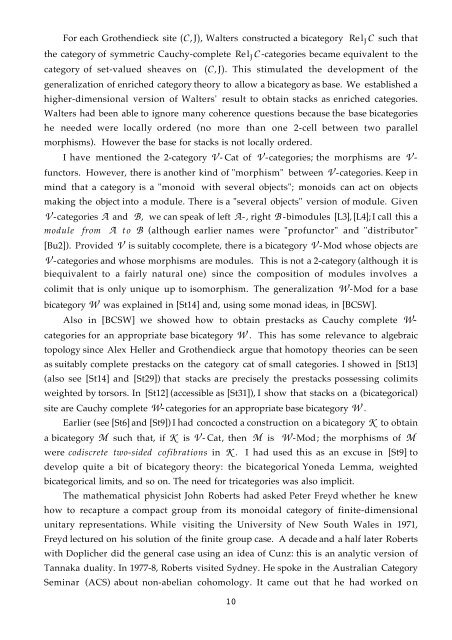An Australian conspectus of higher categories - Macquarie University
An Australian conspectus of higher categories - Macquarie University
An Australian conspectus of higher categories - Macquarie University
You also want an ePaper? Increase the reach of your titles
YUMPU automatically turns print PDFs into web optimized ePapers that Google loves.
For each Grothendieck site ( C ,J),<br />
Walters constructed a bicategory Rel JC such that<br />
the category <strong>of</strong> symmetric Cauchy-complete Rel JC -<strong>categories</strong> became equivalent to the<br />
category <strong>of</strong> set-valued sheaves on ( C ,J).<br />
This stimulated the development <strong>of</strong> the<br />
generalization <strong>of</strong> enriched category theory to allow a bicategory as base. We established a<br />
<strong>higher</strong>-dimensional version <strong>of</strong> Walters' result to obtain stacks as enriched <strong>categories</strong>.<br />
Walters had been able to ignore many coherence questions because the base bi<strong>categories</strong><br />
he needed were locally ordered (no more than one 2-cell between two parallel<br />
morphisms). However the base for stacks is not locally ordered.<br />
I have mentioned the 2-category V - Cat <strong>of</strong> V -<strong>categories</strong>; the morphisms are V -<br />
functors. However, there is another kind <strong>of</strong> "morphism" between V -<strong>categories</strong>. Keep in<br />
mind that a category is a "monoid with several objects"; monoids can act on objects<br />
making the object into a module. There is a "several objects" version <strong>of</strong> module. Given<br />
V -<strong>categories</strong> A and B , we can speak <strong>of</strong> left A-, right B -bimodules [L3], [L4]; I call this a<br />
module from A to B (although earlier names were "pr<strong>of</strong>unctor" and "distributor"<br />
[Bu2]). Provided V is suitably cocomplete, there is a bicategory V -Mod whose objects are<br />
V -<strong>categories</strong> and whose morphisms are modules. This is not a 2-category (although it is<br />
biequivalent to a fairly natural one) since the composition <strong>of</strong> modules involves a<br />
colimit that is only unique up to isomorphism. The generalization W -Mod for a base<br />
bicategory W was explained in [St14] and, using some monad ideas, in [BCSW].<br />
Also in [BCSW] we showed how to obtain prestacks as Cauchy complete W-<br />
<strong>categories</strong> for an appropriate base bicategory W . This has some relevance to algebraic<br />
topology since Alex Heller and Grothendieck argue that homotopy theories can be seen<br />
as suitably complete prestacks on the category cat <strong>of</strong> small <strong>categories</strong>. I showed in [St13]<br />
(also see [St14] and [St29]) that stacks are precisely the prestacks possessing colimits<br />
weighted by torsors. In [St12] (accessible as [St31]), I show that stacks on a (bicategorical)<br />
site are Cauchy complete W- <strong>categories</strong> for an appropriate base bicategory W .<br />
Earlier (see [St6] and [St9]) I had concocted a construction on a bicategory K to obtain<br />
a bicategory M such that, if K is V - Cat, then M is W -Mod; the morphisms <strong>of</strong> M<br />
were codiscrete two-sided c<strong>of</strong>ibrations in K . I had used this as an excuse in [St9] to<br />
develop quite a bit <strong>of</strong> bicategory theory: the bicategorical Yoneda Lemma, weighted<br />
bicategorical limits, and so on. The need for tri<strong>categories</strong> was also implicit.<br />
The mathematical physicist John Roberts had asked Peter Freyd whether he knew<br />
how to recapture a compact group from its monoidal category <strong>of</strong> finite-dimensional<br />
unitary representations. While visiting the <strong>University</strong> <strong>of</strong> New South Wales in 1971,<br />
Freyd lectured on his solution <strong>of</strong> the finite group case. A decade and a half later Roberts<br />
with Doplicher did the general case using an idea <strong>of</strong> Cunz: this is an analytic version <strong>of</strong><br />
Tannaka duality. In 1977-8, Roberts visited Sydney. He spoke in the <strong>Australian</strong> Category<br />
Seminar (ACS) about non-abelian cohomology. It came out that he had worked on<br />
10
















